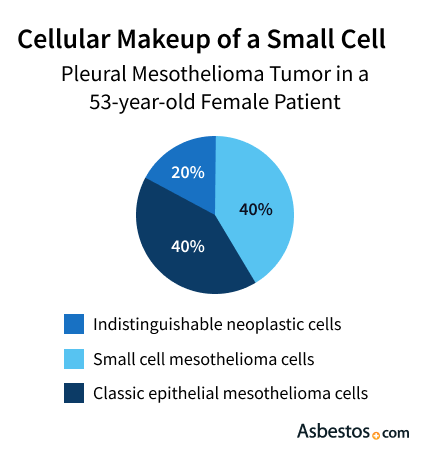Small Cell Mesothelioma
Small cell mesothelioma is an extremely rare subtype of malignant mesothelioma. Although often mistaken for small cell lung cancer (SCLC), small cell mesothelioma forms on the lining of the lungs, while SCLC develops inside the lungs.
What Is Small Cell Mesothelioma?
Small cell mesothelioma is a subtype of epithelial cell mesothelioma. However, many mesothelioma tumors with small cell features are biphasic, which means they contain a combination of epithelial and sarcomatoid cells.

Small Cell Mesothelioma Facts
- Extremely rare variant of mesothelioma
- Misdiagnosed as other types of cancer
- Differentiated using immunohistochemistry
- Doctors use standard mesothelioma treatment approaches
This type of mesothelioma grows in a pattern like small cell carcinoma. However, the tumors do not display the stream, ribbon or rosette patterns in the subtype of lung carcinoma.
Small cell mesothelioma tumors grow in the peritoneum (abdominal lining), but they can also arise in the pleura (lung lining) or the pericardium (heart sac). Most of these tumors are not entirely composed of small cells. Instead, they often contain normal mesothelioma and other assorted neoplastic cells. For a tumor to qualify as this type, roughly half or more of all cells should display a small cell pattern.
Diagnosis of Small Cell Mesothelioma
Diagnosing this cell type is difficult because the cells look like other small cell neoplasms. Doctors must run immunohistochemical tests to differentiate between the diseases.
Conditions Similar to Small Cell Mesothelioma
- Small cell lung carcinoma (SCLC)
- Desmoplastic small round cell tumor (DSRCT)
- Peripheral neuroectodermal tumor (PNET)
- Lymphoma
A single biopsy may not always contain a representative sample of the cells in the entire tumor. In one study, small cells comprised 80% to 100% of the biopsy material. But only 15% to 20% of the whole tumor. Doctors may retrieve several samples to make an accurate mesothelioma diagnosis.
After immunohistochemical staining, the tumor cells will test positive for different compounds. This result helps the medical team narrow the diagnosis. Small cell mesothelioma and small cell carcinoma have similar-looking cells. However, each disease reacts to different chemical markers.
Diagnosing the right type is vital because different cancers respond to other treatments.

Get specialized treatment from experienced mesothelioma doctors.
Find a Doctor NowSmall Cell Mesothelioma Treatment and Prognosis
Developing a standard of treatment for small cell mesothelioma is difficult. Because doctors have not reported many cases, they must rely on standard mesothelioma treatment approaches.
Small cell lung cancer (SCLC) is more aggressive than other types of lung cancer. It is unclear if the prognosis for small cell mesothelioma differs from other epithelial mesotheliomas.
In 2020, researchers said small cell mesothelioma has a similar cell morphology to SCLC but a different immunohistochemical profile. They concluded that the rare variant has a poor prognosis, with a mean survival of about 8 months.
Recommended Reading


